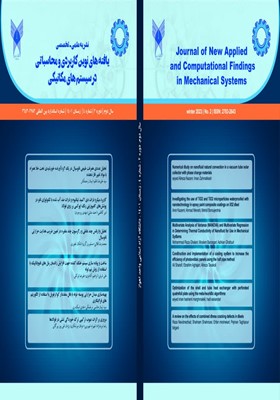ساخت و پیاده سازی سیستم خنک کننده جهت افزایش راندمان پنل های فتوولتاییک با استفاده از روش نیم لوله
محورهای موضوعی : یافته های نوین کاربردی و محاسباتی در سیستم های مکانیکی
علی شرفی
1
,
ابراهیم آقاجری
2
*
![]() ,
علیرضا توکلی
3
,
علیرضا توکلی
3
1 - دانشجوی کارشناسی ارشد، گروه مهندسی برق، واحد اهواز، دانشگاه آزاد اسلامی ، اهواز، ایران
2 - استادیارگروه مهندسی برق، واحد اهواز، دانشگاه آزاد اسلامی ، اهواز، ایران
3 - استادیارگروه مهندسی برق، واحد اهواز، دانشگاه آزاد اسلامی ، اهواز، ایران
کلید واژه: سیستم فتوولتائیک, افزایش بازده, حسگر دما, پنل خورشیدی, سیستم خنکسازی,
چکیده مقاله :
خنک سازی پنل ها با استفاده از روش نیم لوله یکی از مهمترین روشهای مورد استفاده جهت افزایش بازده منابع خورشیدی است. از این رو، در این مقاله، یک پروژه عملی برای ساخت یک پنل خورشیدی مبتنی بر روش خنک سازی نیم لوله با هدف افزایش بازدهی پنلهای خورشیدی انجام شده است. در طرح پیشنهادی، نیملولهها مستقیماً روی سطح زیرین پنل تعبیه شدهاند. سیال موجود که در این تکنیک آب میباشد درون نیم لوله ها و در تماس مستقیم با پنل بوده و فرآیند خنک سازی را به صورت مارپیچ روی سطح پنل انجام می دهد. از دو پنل جهت مقایسه عملکرد پنل مجهز به نیم لوله و پنل فاقد این سیستم بهره گرفته شده که پنلها دارای ابعاد 180*150و توان 200 وات میباشد. از سه حسگر هم برای اندازهگیری دمای پنلها و محیط استفاده شده است. نتایج بیانگر این است که بکارگیری روش نیم لوله میتواند دمای پنلها را تا حدود 10 درجه سانتیگراد کاهش دهد. علاوه بر این، نتایج بیانگر افزایش بازده 36 درصدی پنل خورشیدی با بکارگیری روش نیملوله می باشد.
Cooling panels using the half pipe method is one of the most important methods used to increase the efficiency of solar resources. In this article, a practical project for cooling a solar panel based on the half-pipe method has been carried out with the aim of increasing the efficiency of solar panels. In the proposed design, the half-pipes are installed directly on the bottom surface of the panel, and the available fluid, which is water in this technique, is inside the half-pipes and in direct contact with the panel, and performs the cooling process in a spiral on the surface of the panel. Two panels have been used to compare the performance of a panel equipped with a half pipe and a panel without this system, the panels have dimensions of 150 x 180 and power of 200 watts. Three sensors have been used to measure the temperature of the panels and the environment. The results show that using the half-pipe method can reduce the temperature of the panels by about 10 degrees Celsius. In addition, the results show a 36% increase in solar panel efficiency by using the half-pipe method.
[1] انجوی ارسنجانی، م.، یعقوبی، م.، جعفرپور، خ.، (1393)، ارزیابی پتانسیل انرژی خورشیدی در چند اقلیم آب و هوایی ایران با استفاده از روش شبکه عصبی، اولین کنفرانس و نمایشگاه بین المللی انرژی خورشیدی.
[2] عبدی علمی، الف.، میرعبداله لواسانی، الف.، (1396)، مروری بر روش ها و کارهای انجام شده در زمینه خنک سازی پنل های فتوولتاییک در جهت افزایش راندمان الکتریکی پنل، سومین کنفرانس بین المللی پژوهش در علوم و مهندسی.
[3] Salehi, R., Jahanbakhshi, A., Golzarian,M . R., Khojastehpour, M., (2021), Evaluation of solar panel cooling systems using anodized heat sink equipped with thermoelectric module through the parameters of temperature, power and efficiency. Energy Conversion and Management: X 11, pp 100-102.
[4] Laseinde, O. T., Ramere, M. D., (2021), Efficiency Improvement in polycrystalline solar panel using thermal control water spraying cooling. Procedia Computer Science 180, pp 239-248.
[5] Li, D., King, M., Dooner, M., Guo, S., Wang, J., (2021), Study on the cleaning and cooling of solar photovoltaic panels using compressed airflow. Solar Energy 221, pp 433-444.
[6] Bhakre, S. S., Sawarkar, P. D., Kalamkar, V. R., (2021), Performance evaluation of PV panel surfaces exposed to hydraulic cooling–A review. Solar Energy 224, pp 1193-1209.
[7] Ruoping, Y., Xiaohui, Y., Fuwei, L., Huajun, W., (2020), Study of operation performance for a solar photovoltaic system assisted cooling by ground heat exchangers in arid climate, China. Renewable Energy 155, pp 102-110.
[8] Abdel-Khalik, S., (1976). Heat removal factor for a flat-plate solar collector with a serpentine tube. Solar Energy 18(1), pp 59-64.
[9] Maadi, S. R., Kolahan, A., Passandideh-Fard, M., Sardarabadi, M., Moloudi, R., (2017), Characterization of PVT systems equipped with nanofluids-based collector from entropy generation. Energy conversion and management 150, pp 515-531.
[10] عفرپور، س. و صادق زاده، س. م.، (1400)، خنکسازی پنلهای فتوولتاییک، راهبردی برای آینده، هفتمین کنفرانس بین المللی فناوری و مدیریت انرژی، اردبیل.
[11] صدرزاده خراسانی، م.، نصرالله زاده، ب.، نوعی، س. م.، (1395)، شبیهسازی و بهینهسازی خنک کردن یک پنل خورشیدی، کنگره بین المللی نوآوری در مهندسی و توسعه تکنولوژی، تبریز.
[12] Salehi, R., Jahanbakhshi, A., Golzarian, M. R., Khojastehpour, M., (2021), Evaluation of solar panel cooling systems using anodized heat sink equipped with thermoelectric module through the parameters of temperature, power and efficiency, Energy Conversion and Management: X 11, pp 100102.
[13] Han, J., Zhang, X., Yeung, R. W., (2022), Hydrodynamic behavior of a circular floating solar pond with an entrapped two-layer fluid. Physics of Fluids, 34(1), 012114.
[14] Shrivastava, A., Jose, J. P. A., Borole, Y. D., Saravanakumar, R., Sharifpur, M., Harasi, H., Afzal, A. (2022), A study on the effects of forced air-cooling enhancements on a 150 W solar photovoltaic thermal collector for green cities. Sustainable Energy Technologies and Assessments, 49, 101782.
_||_
